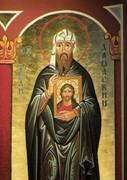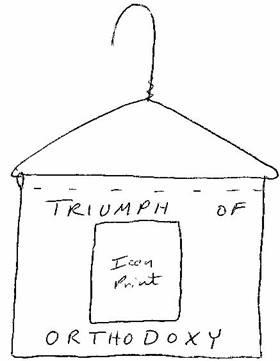Triumph of Orthodoxy
SUNDAY OF ORTHODOXY/ST. JOHN OF DAMASCUS
 Objectives:
Objectives:
- Students should know that on “Sunday of Orthodoxy” we celebrate the return of the icons to the church.
- Students should be able to define icon and iconclasm.
- Students should know the roles of Empress Irene, Empress Theodosia, and St. John of Damascus in the defeat of iconoclasm.
- Students should know that the 7th Ecumenical Council condemned iconoclasm.
Possible Lesson Plan:
- Open with prayer.
- Tell the story of the Sunday of Orthodoxy:
From its earliest days, Christians made pictures of Jesus, Mary, and important events in Christian history. They drew them on the walls of their tombs, deep in the catacombs under the city of Rome. They drew on the walls of their churches and monasteries. Most people could not read in those days. They did not worship these pictures but used them as “windows to heaven” – to remember the life of Jesus, His teachings, and the lives and teachings of His holy ones, the saints.
But, there came a day about 700 years after the time of Jesus, when a wicked emperor in Constantinople, another Leo, decided to get rid of the icons. He, and later his son, another Constantine, burned the monasteries and killed the monks and looted the churches, trying to destroy all the icons. Icons were hidden to keep them safe.
At this time, there lived in Damascus, a city under the rule of an Arab caliph (or king), a man named John; we know him now as John of Damascus. John was wise and charming; soon he was the caliph’s second-in-command. The caliph was a Moslem, but John was a Christian. John taught and wrote about his love of icons. Emperor Leo did not like this and tried to have John killed. He told lies to the caliph, saying John was going to betray him to the Greeks, and the caliph believed Leo. He had John’s hand cut off. John prayed and his hand was healed! Then John left the palace and went to live in a monastery. There he wrote many hymns and prayers and even invented the series of eight tones for singing we use today in church.
Finally, the Empress Irene called for a council of the bishops. This was the seventh and last church council. The church stood firmly for bringing the icons back! But, the emperors were still opposed. Finally, the Empress Theodosia brought the icons back into the churches. There was such rejoicing. And, to this day, we celebrate the return of the icons with a great procession of icons on the “Sunday of Orthodoxy”.
- Discuss icons: What are they? Let the students discuss a bit. A display of icons or pictures of famous icons will help. Does the student have a favorite icon? How are they different from other pictures? How do we venerate an icon? (practice kissing and making the sign of the cross)What is the difference between veneration and worhip? Where do we put an icon? Does the student have an icon corner in his home? In his room? Maybe this would be a good time to start. Take an icon of a feast and show how it tells the story of the feast. Could someone learn this story even if he couldn’t read? Do any of the students remember how we celebrate the Triumph of Orthodoxy? Have they marched with the priests and others around the church carrying their icons? Use our study sheet to learn how to identify the type of saint depicted in each icon:
- Play a learning game: The Big Step – Line the students up at one end of the classroom; teacher at the other. Each student in turn gets to answer a question from today’s lesson; if successful, he moves one step toward the teacher. If unsuccessful, the question goes to the next student. First student to reach the teacher is the winner.
Sample questions:
Who defended icons to the Arab caliph?
Where did John live?
Which emperor began the destruction of icons?
Who called the 7th Ecumenical Council?
Where was the 7th Council held?
What heresy was condemned at the 7th Council?
Which Empress led the Triumph of Orthodoxy?
 Make a Triumph of Orthodoxy Banner: Take a piece of felt. Staple one end over a wire hanger. Glue on an icon print; we have a vast array of old bulletin covers. Write with magic marker or felt letters “Triumph of Orthodoxy”.
Make a Triumph of Orthodoxy Banner: Take a piece of felt. Staple one end over a wire hanger. Glue on an icon print; we have a vast array of old bulletin covers. Write with magic marker or felt letters “Triumph of Orthodoxy”.
- Close with prayer: Stand before your class icons and venerate first, then pray, Lord, may I honor Your life and Your Mother and all Your Saints each day of my life.